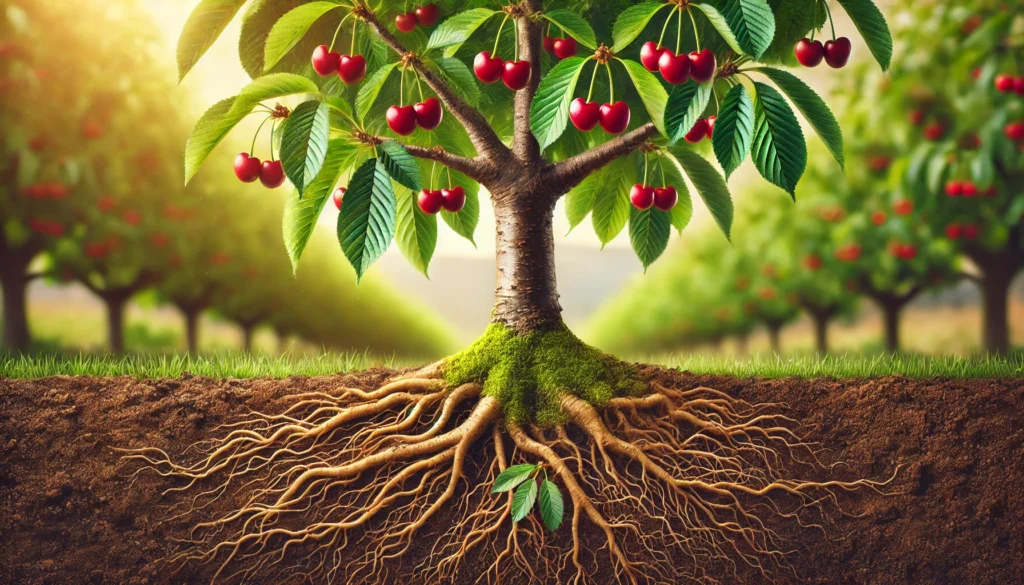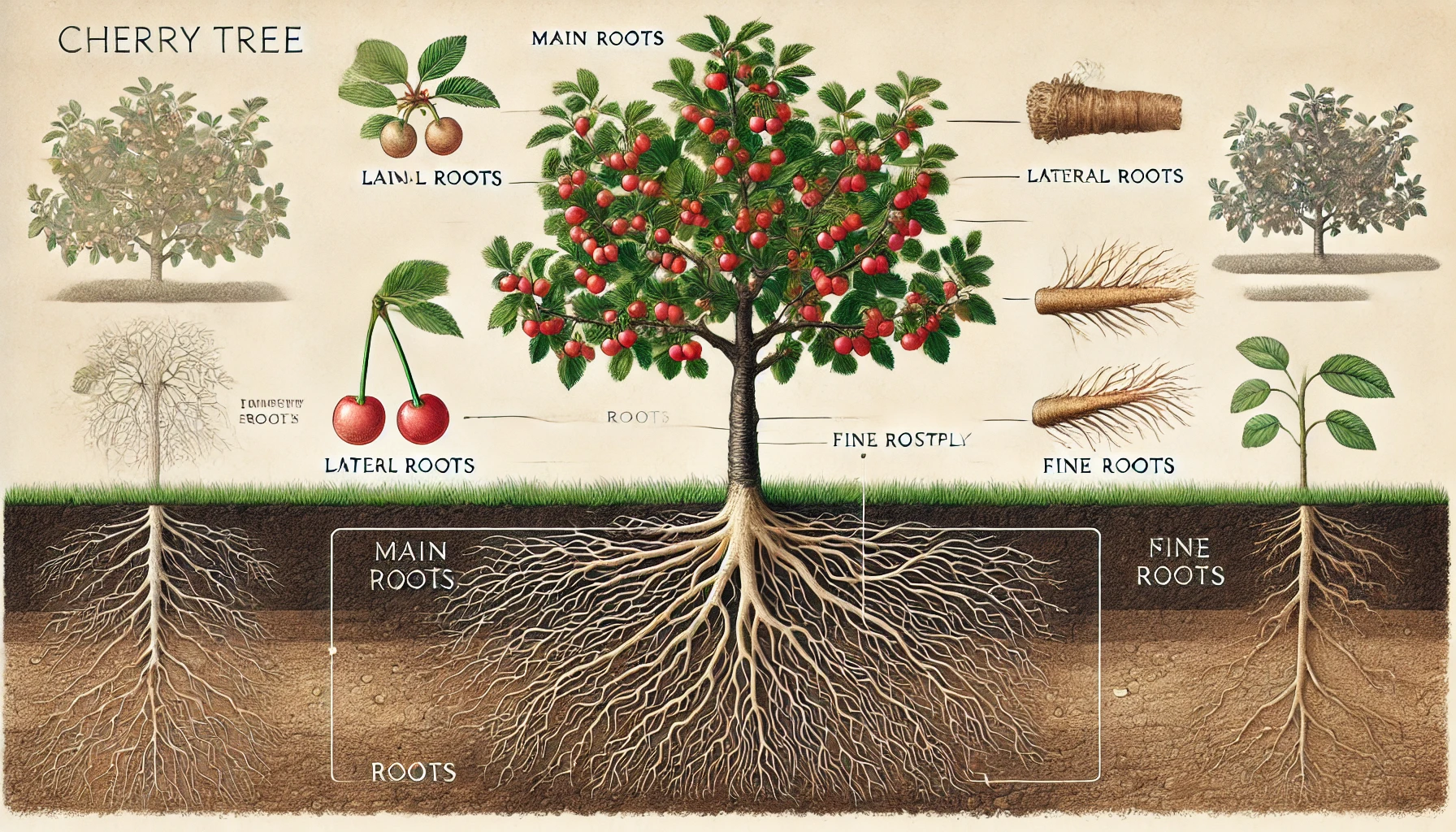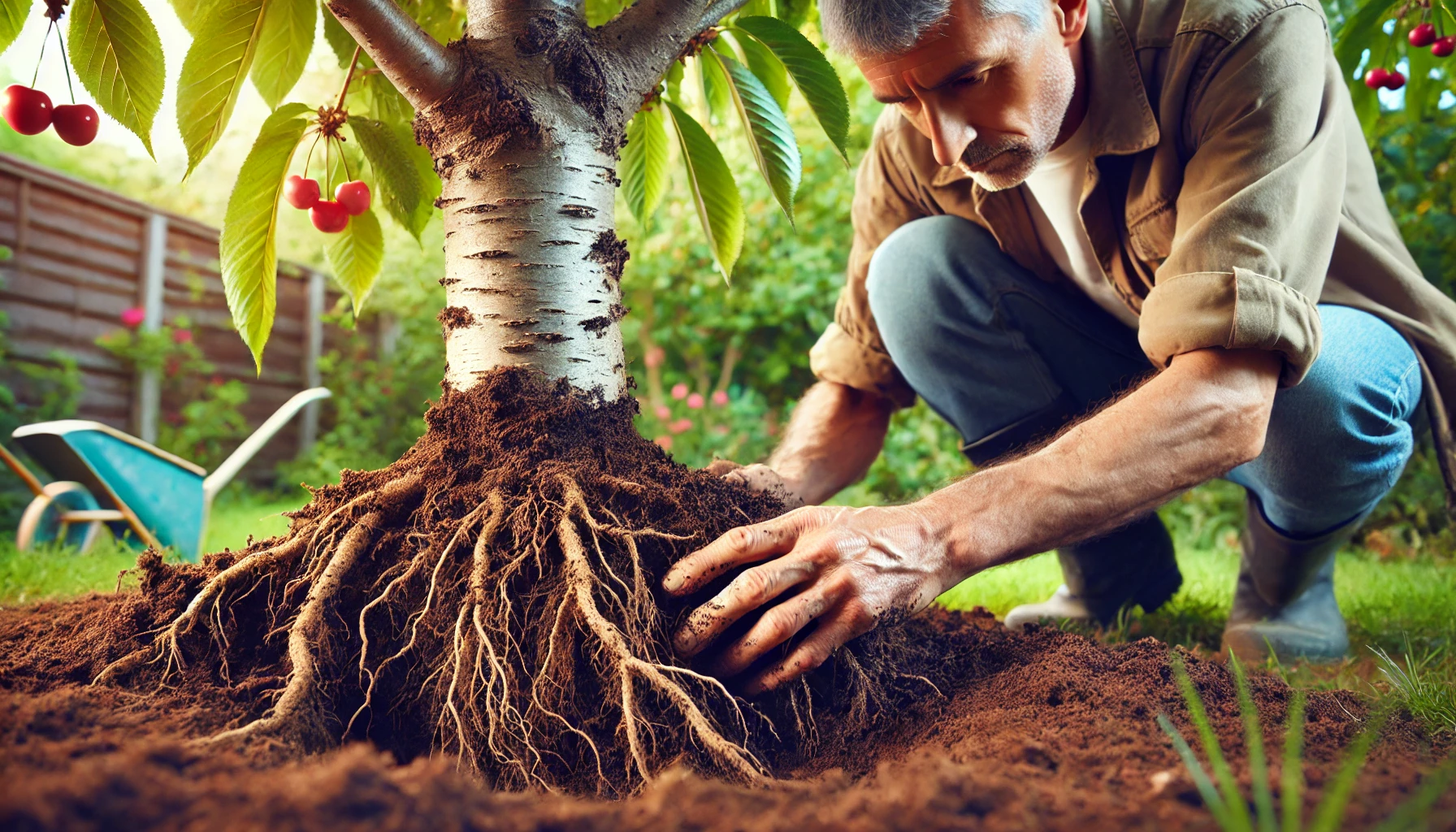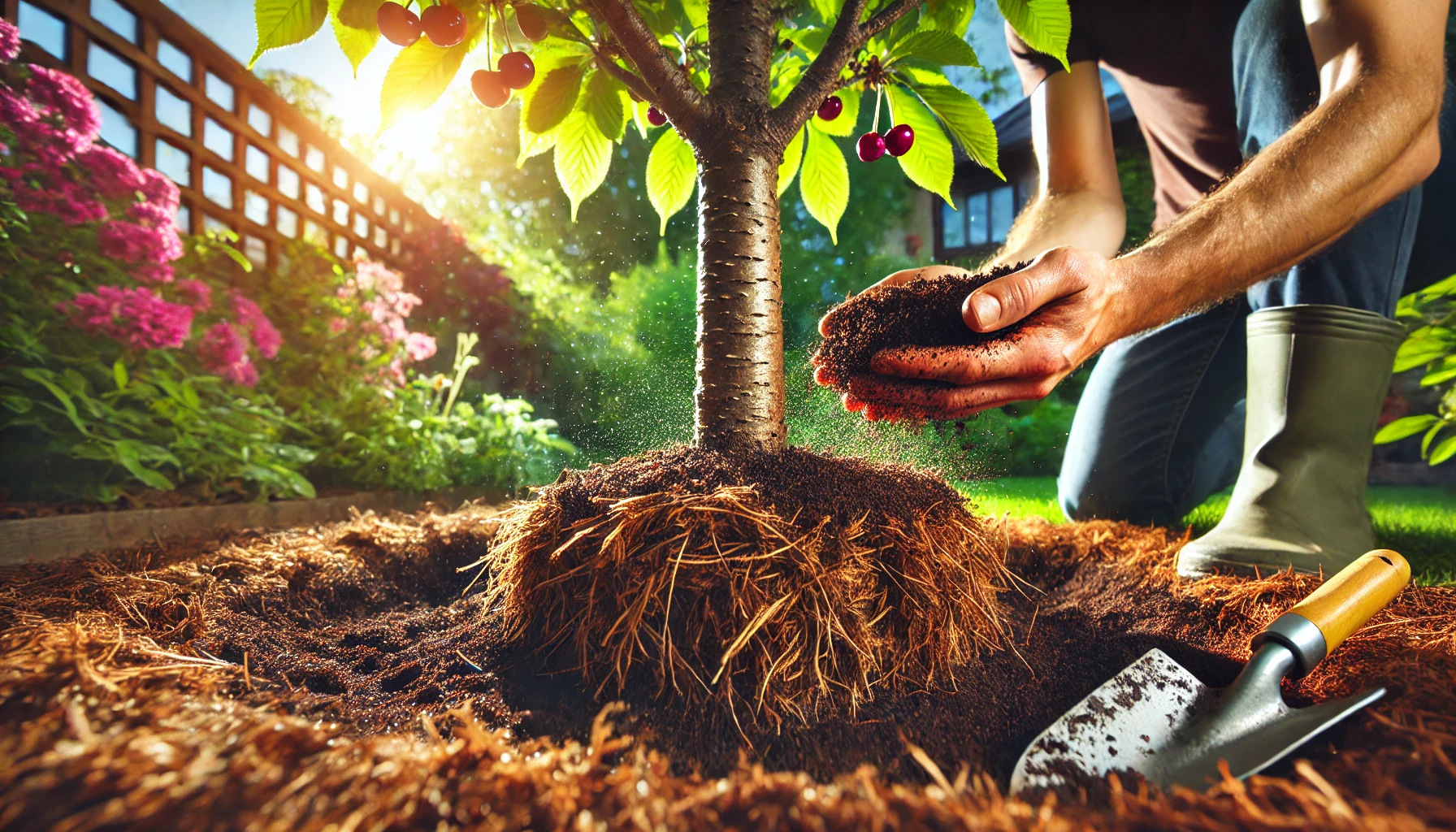
Understanding Cherry Tree Root Systems: How to Avoid Damage and Promote Growth
Cherry trees are a beautiful addition to any garden, but their root systems are often overlooked—until damage occurs. Understanding cherry tree root systems: how to avoid damage is crucial for maintaining the health and longevity of your tree. Roots are the foundation that nourishes your tree, yet they are also vulnerable to stress, disease, and improper care. In this guide, we’ll walk you through essential insights on how to protect and nurture your cherry tree’s roots, ensuring robust growth and preventing costly damage. Let’s dive into how you can keep your tree’s foundation strong and thriving for years to come!
Table of Contents
ToggleWhy Cherry Tree Roots Matter: The Foundation of Your Tree 
The roots of a cherry tree are much more than just a part of its structure—they’re the tree’s lifeline. 

- Stability and Support
The roots anchor the cherry tree to the soil, ensuring it remains upright and withstands wind, rain, and other environmental factors. A deep, expansive root system helps the tree stay firm, even as it grows tall and produces heavy fruit. - Water and Nutrient Absorption
Roots are responsible for absorbing water and nutrients from the soil, which are essential for the cherry tree’s overall health. The better the roots, the more efficient the tree is at getting what it needs to grow and fruit. - Growth and Fruit Production
A healthy root system promotes strong, consistent growth. With the right balance of nutrients and water, your cherry tree will flourish, producing better fruit yields year after year.
Understanding the importance of your cherry tree’s roots is key to ensuring it thrives for years to come. By focusing on root health, you set the foundation for a healthy, productive tree!
Common Causes of Cherry Tree Root Damage 
Cherry tree roots are sensitive, and even small issues can cause serious damage. Understanding the common causes of root damage will help you protect your tree and keep it healthy. Here are the key culprits:
- Overwatering
Excess water can suffocate the roots, preventing them from absorbing oxygen. This leads to root rot, which weakens the tree. Ensure proper drainage and avoid waterlogging. - Poor Soil Drainage
Soil that doesn’t drain well can cause water to pool around the roots. This promotes fungal growth and root rot. If your soil is heavy, consider amending it with organic matter to improve drainage.
- Compacted Soil
Heavy foot traffic or construction work near the tree can compact the soil, making it difficult for roots to spread. Roots need loose, well-aerated soil to grow properly. Use mulch or consider aerating the soil to prevent compaction. - Invasive Root Systems
Nearby trees or plants with aggressive root systems can invade your cherry tree’s roots, stealing nutrients and water. Keep a distance between your cherry tree and other plants with invasive roots to reduce competition. - Pests and Diseases
Root pests like root weevils or nematodes can damage the roots, leading to weakness and even death of the tree. Regularly inspect the soil and roots for signs of pests or disease. - Improper Planting
Planting your cherry tree too deep or too shallow can stress the roots. The tree should be planted at the same depth as it was in the nursery pot, with the root flare visible above the soil level.
By identifying these common causes early, you can take steps to protect your cherry tree’s roots and ensure its long-term health!
How to Identify Root Damage in Cherry Trees 
Root damage in cherry trees can be tricky to spot, but early detection is key to preventing long-term harm. Here are a few signs to look for:
- Wilting Leaves
Even with adequate watering, wilting leaves can indicate poor root health. If your cherry tree’s leaves droop and yellow despite regular care, the roots may be struggling. - Stunted Growth
If your cherry tree is not growing as expected, this could be a sign that its roots are damaged and unable to supply nutrients properly. - Discolored or Dry Soil
Dry, cracked soil around the base of the tree can be a red flag. Healthy roots need moisture to thrive—if the soil is unusually dry, it could indicate root damage.
- Poor Fruit Development
A healthy cherry tree produces an abundance of fruit. If your tree produces fewer or smaller cherries than usual, root damage might be affecting nutrient absorption - Loose Bark or Cracked Trunk
Sometimes, root damage affects the tree’s ability to support its structure. If the bark is peeling or the trunk is cracked, it could point to severe root issues. - Fungal Growth or Rot
Check the soil for signs of mold or foul-smelling dampness. Root rot caused by overwatering or poor drainage often leads to fungal growth.
What to Do If You Spot Root Damage 
If you notice these signs, inspect the roots carefully. Gently dig around the base and look for broken, discolored, or mushy roots. Prune any damaged parts and ensure the tree has well-drained soil. If the problem persists, consider consulting an expert for a more thorough assessment.
By identifying root damage early, you can help your cherry tree recover and thrive again!
Best Practices for Protecting and Maintaining Healthy Cherry Tree Roots 
Cherry trees thrive when their roots are healthy and protected. Here are some expert tips to ensure your tree’s roots stay strong:
- Proper Planting Depth
When planting your cherry tree, ensure the root ball sits just above the ground level. Planting too deep can suffocate the roots, leading to poor growth. - Mulch for Moisture Retention
Apply a 2-3 inch layer of mulch around the base of your tree, but keep it away from the trunk. Mulch helps retain moisture, regulates soil temperature, and reduces weed competition. - Avoid Compaction
Compacted soil makes it hard for roots to grow. Avoid heavy foot traffic or machinery around the tree. If soil compaction occurs, aerate the soil to improve root oxygenation. - Watering Wisely
Deep watering is crucial for cherry tree roots. Water deeply once a week during dry periods, ensuring the water reaches the root zone. Avoid shallow, frequent watering that encourages surface root growth. - Root Pruning (When Necessary)
Prune any damaged or diseased roots during tree maintenance. Ensure you use clean, sharp tools to avoid infecting the tree with harmful pathogens.
- Avoid Overfertilizing
Excessive fertilizer can harm the roots. Apply fertilizer sparingly, using organic options like compost, which is gentler on the root system and promotes healthier growth.
By following these best practices, you’ll give your cherry tree’s roots the best chance to flourish, leading to a healthier, more fruitful tree!
Root Pruning: When and How to Do It Safely 
Root pruning is a crucial technique for maintaining plant health, promoting growth, and preventing root-bound issues. Let’s dive into when and how to safely prune your plant’s roots.
When to Prune Roots 
- During Repotting: The best time to prune roots is when you’re repotting your plant. This is the perfect opportunity to refresh the soil and give the roots room to grow.
- Spring or Early Summer: For most plants, pruning during the active growing season helps them recover quickly. Avoid pruning in winter when plants are dormant.
How to Prune Roots 
- Remove the Plant: Gently take the plant out of its pot. Be careful not to damage the roots.
- Examine the Roots: Look for any roots that are tangled, damaged, or rotting. These should be removed to promote healthier growth.
- Trim the Roots: Use clean, sharp scissors or pruning shears to cut away no more than 1/3 of the root mass. Focus on cutting the thicker, older roots, and leave the healthy ones intact.
- Repot Immediately: After pruning, place the plant in a slightly larger pot with fresh, well-draining soil. Water well to help it settle in.
Tips for Safe Root Pruning 
- Always sterilize your tools before use to prevent infections.
- Prune gently—over-pruning can stress the plant, so be conservative.
- Make sure your new pot has drainage holes to prevent waterlogged roots.
Root pruning is an easy yet effective way to ensure your plant thrives for years to come. Follow these steps to safely prune and promote healthy root growth!
Promoting Growth Through Proper Root Care 
Roots are the lifeblood of your plants, providing essential nutrients and water. Proper root care is crucial to ensure your plant thrives and grows strong. Here are some expert tips to promote healthy root development and overall plant growth:
- Choose the Right Soil
Healthy roots start with the right soil. Use well-draining soil that allows air to reach the roots while retaining moisture. A balanced mix of organic matter, sand, and perlite works wonders for most plants. - Watering Techniques
Overwatering can suffocate roots, while underwatering can lead to root dehydration. Water the plant deeply, ensuring the water reaches the root zone, but let the soil dry out slightly between waterings. - Avoid Root Compaction
Compacted soil can restrict root growth. Gently loosen the soil when planting to allow the roots room to expand. In pots, choose a container with drainage holes to prevent compaction.
- Fertilize Smartly
Roots need nutrients to grow. Use a balanced fertilizer, but avoid over-fertilizing, which can burn the roots. Feed plants during the growing season for the best results. - Repot When Necessary
As plants grow, their roots can outgrow their pots. Repot your plants into larger containers when you notice roots growing through the drainage holes or the plant seems root-bound. This promotes healthier root expansion. - Check for Root Rot
Root rot can stunt growth and even kill plants. If you notice wilting or yellowing leaves despite proper care, check the roots. Trim away any soft, mushy, or brown roots and repot the plant in fresh soil.
By following these simple root care practices, you’ll ensure your plant has a solid foundation for vibrant growth.
Protecting Cherry Tree Roots from Pests and Diseases 
Cherry trees are susceptible to various pests and diseases that can damage their roots, leading to poor growth and even tree death. Protecting your tree’s roots is crucial for maintaining its health and productivity. Here’s how you can safeguard your cherry tree roots effectively:
1. Monitor for Root Pests 
Common root pests like root weevils, nematodes, and ants can cause significant damage. To prevent an infestation:
- Regularly inspect soil and roots for signs of pests such as holes or unusual patterns of damage.
- Introduce beneficial nematodes into the soil to target harmful pests without harming your tree.
2. Improve Soil Drainage 
Poor drainage can lead to root rot, which weakens the tree and makes it vulnerable to diseases. Ensure your cherry tree:
- Is planted in well-draining soil, or amend heavy soil with organic matter like compost.
- Avoid overwatering, as this can saturate the soil and encourage fungal growth.
3. Use Mulch Wisely 
Mulching around the base of your tree can help regulate soil temperature and moisture levels, but be careful:
- Keep mulch away from the tree trunk to prevent fungal diseases.
- Use organic mulch, such as wood chips, to discourage root-feeding pests and promote healthy soil.
4. Fungicide Application 
Root diseases like Phytophthora can spread quickly. Applying a root-targeting fungicide can help prevent these infections, especially during rainy seasons. Always follow the product’s instructions for safe and effective use.
5. Healthy Soil = Healthy Roots 
Maintaining healthy soil is key to preventing both pests and diseases:
- Aerate the soil around the root zone annually to improve oxygen flow.
- Test your soil regularly for pH and nutrient levels, and amend as necessary to keep it optimal for cherry tree health.
By staying vigilant and following these tips, you can protect your cherry tree’s roots from harmful pests and diseases, ensuring it remains strong and fruitful year after year.
How to Transplant Cherry Trees Without Damaging Their Roots 

Transplanting a cherry tree is a delicate task, especially when it comes to preserving its roots. Here’s how to do it effectively and ensure your tree thrives in its new spot:

- Timing is Key
The best time to transplant a cherry tree is during its dormant period, either in late fall or early spring. This minimizes stress and helps the tree settle into its new environment without putting energy into growth. - Prepare the New Site Beforehand
Choose a location that offers plenty of sunlight and well-drained soil. Dig a hole that’s twice as wide as the root ball but the same depth. This allows the roots to spread out easily. - Water the Tree Before Digging
A day before transplanting, water the tree thoroughly. This softens the soil and makes it easier to dig around the roots. - Digging Out the Tree with Care
Start by digging a trench around the tree, a few inches away from the trunk. Dig deep enough to get as much of the root system as possible. Try to keep the roots intact and avoid cutting them. - Minimize Root Disturbance
When lifting the tree, gently lift the root ball with a tarp or burlap cloth. This keeps the roots bundled together and reduces the risk of damage. Avoid shaking the roots loose. - Handle with Caution
Once the tree is out of the ground, transport it to its new home. Hold the root ball carefully, supporting it fully to prevent any damage. - Plant and Water Immediately
Place the tree in the prepared hole, ensuring it sits at the same depth as before. Fill the hole with soil and water generously to settle the roots. - Monitor the Tree
After transplanting, water the tree consistently for the next few weeks. Mulch around the base to keep moisture in and prevent weeds from growing.
By following these simple steps, you can successfully transplant a cherry tree while keeping its roots healthy and intact. Your tree will have a great start in its new location, ready to flourish for years to come!
Conclusion 
In conclusion, understanding your cherry tree’s root system is essential for maintaining its health and ensuring long-term growth. By taking steps to avoid damage, such as proper watering, soil care, and regular monitoring for pests, you can promote a strong, resilient root system that supports the entire tree. Root protection and maintenance aren’t just about preventing harm—they’re about fostering an environment where your tree can thrive. With the expert tips provided in this article, you now have the knowledge to nurture your cherry tree from the ground up. Keep an eye on your roots, and your tree will reward you with abundant growth, vibrant foliage, and a bountiful harvest for years to come!
Frequently Asked Questions(FAQ)
Why is it important to understand a cherry tree's root system?
Understanding the root system is crucial for ensuring your cherry tree’s health and vitality. A healthy root system anchors the tree, absorbs water and nutrients, and provides stability. By understanding it, you can avoid practices that damage the roots, ultimately promoting better growth and fruit production.
What are the signs that my cherry tree's roots are damaged?
Signs of root damage include poor tree growth, yellowing leaves, wilting, or stunted fruit production. If you notice these symptoms, it’s important to check for root rot, compacted soil, or pests that could be affecting the root health.
How can I avoid damaging my cherry tree’s roots during gardening?
To protect your tree’s roots, avoid digging too close to the trunk, especially when planting or adding mulch. Be cautious when using heavy machinery near the tree, and always use well-draining soil to prevent waterlogging that can harm the roots.
Can I prune cherry tree roots?
Pruning cherry tree roots should only be done with caution and by professionals. If necessary, prune only a small portion of the roots to avoid compromising the tree’s overall health and stability. Major root pruning can shock the tree and even cause it to die.
How do I promote healthy root growth in my cherry tree?
To promote healthy root growth, ensure the tree is planted in well-drained, fertile soil. Water the tree deeply and consistently, particularly in dry periods, and avoid over-watering. Additionally, mulching around the base can help maintain soil moisture and protect roots from extreme temperatures.
How does soil affect my cherry tree's root system?
Soil quality plays a vital role in root health. Sandy loam with good drainage is ideal for cherry trees. Poorly drained or compacted soils can lead to root rot, while too-dry soil can deprive the roots of water and nutrients. Regularly aerating the soil can prevent compaction and support healthy root expansion.
Can pests damage my cherry tree's roots?
Yes, pests such as root-feeding insects, nematodes, and rodents can damage cherry tree roots. Signs of pest damage may include wilting, stunted growth, and discolored leaves. Regular inspection and the use of natural pest control methods can help protect your tree’s roots.
How can I improve the soil around my cherry tree's roots?
Improving soil around your cherry tree’s roots involves adding organic matter, like compost, to increase fertility and improve drainage. Aerating the soil gently around the tree can also promote root expansion and oxygen circulation. Be careful not to disturb the roots too much during this process.
















